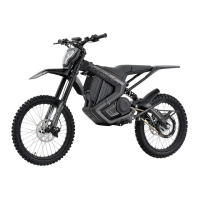riding pants with knee and hip pads, a jersey with elbow pads, and a chest/ shoulder
protector.
Avoid wearing loose or baggy clothes that could get caught on any part of the dirt
bike (All-Terrain Bike).
Do not let anyone else ride your dirt bike (All-Terrain Bike) on their own unless, after
carefully reading this manual, they understand the features, functions, capacities,
abilities, and risks of this dirt bike (All-Terrain Bike). The safety of new riders is your
responsibility. Assist new riders until they are fully capable of operating this dirt bike
(All-Terrain Bike). Make sure other riders also wear approved personal protective
equipment and suitable clothes.
During transportation:
This dirt bike (All-Terrain Bike) is heavy. When moving the dirt bike (All-Terrain
Bike) for riding or service, do not attempt to lift the dirt bike (All-Terrain Bike) alone
to avoid any injury or damage to the dirt bike (All-Terrain Bike).
It is recommended to have the proper protection for the dirt bike (All-Terrain Bike)
and movers at all times when moving and lifting the dirt bike (All-Terrain Bike).
Stay away from sharp and moving parts of the dirt bike (All-Terrain Bike) when
moving the dirt bike (All-Terrain Bike), including but not limited to wheels,
handlebars, gears, chains, footpegs, and any other parts that may hurt.
Securely fixing the dirt bike (All-Terrain Bike) during transport reduces the chances
of injury and damage to the dirt bike (All-Terrain Bike).
When riding:
Riding this dirt bike (All-Terrain Bike) on public streets, highways, or pedestrian
trials is ILLEGAL. This dirt bike (All-Terrain Bike) is for recreational off-road
use on enclosed roads, tracks, and private property.
Riding this dirt bike (All-Terrain Bike) at full power increases the possibility of
an accident regardless of the location. Do not exceed speed limits that jeopardize
conductive capacity, and consider the existing climate and terrain conditions to
avoid accidents or injuries.
Take good care and drive at lower speeds considering the weather and road
conditions.
Riding in extreme weather such as snow, storms, or wild winds or riding on wet,
muddy, icy, or slippery roads for any reason is not recommended.
The braking distance will be extended when riding in rain, snow, or on wet roads.
When the water on the road exceeds 9 inches, it may affect the normal operation
of the brakes.
Always have both hands on the handlebars and both feet on the footpegs. And pay
attention to the road condition and surrounding environment.
Using cell phones, cameras, headphones, earbuds, or any other mobile device is
absolutely forbidden.
Always consider the safety of other drivers and riders.
Slow down and avoid pedestrians and vehicles when approaching or passing

